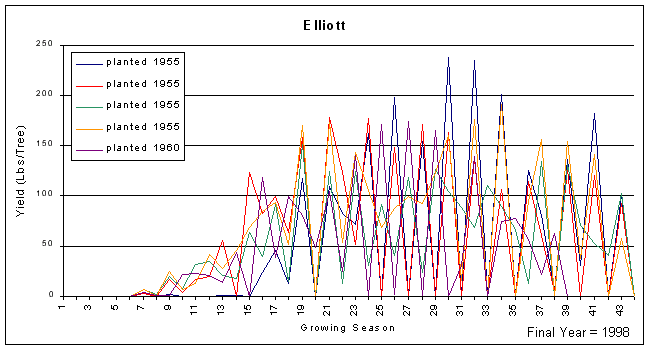Elliott
Average nut quality of 'Elliott' test trees from year 1 to 20.
| # Nuts / lb. | % Kernel | Kernel quality breakdown | Specific gravity | ||
| % Fancy | % Standard | % Amber | |||
| 77 | 51% | 37% | 13% | 1% | 0.80 |
History
The original 'Elliott' tree was a seedling in the lawn of a house in Milton, Fla., purchased by Henry Elliot in 1912. This tree was resistant to scab and produced up to 250 pounds of high quality nuts (Sparks, 1992). Read in depth about 'Elliott'.
Comments
'Elliott' is widely planted in Georgia. Its resistance to scab and excellent quality nuts were responsible for the Georgia Extension Service recommending it for orchard planting in the early 1960's. We still recommend it for growers looking for a cultivar that needs little or no scab protection.
'Elliott' has a small, teardrop-shaped nut of very good quality. Growers should receive a premium price because of its plump, perfect halves. Percentage fill and specific gravity are high. It bears alternately, but nuts are high quality in the "on" years. It is excellent as a party nut, and has a distinct hickory nut flavor. Growers should seek those specialty markets that are aware of the merits of this cultivar, otherwise, it might bring seedling prices. High scab resistance makes it a good choice for home orchard plantings. 'Elliott' is susceptible to late spring freezes and should not be planted in north Georgia, or in low spots. For this area I would recommend 'Kanza' instead. Yellow aphids can be a problem with this cultivar, and young trees are slow to come into production.
Production record of test trees beginning in year planted
'Elliot' production from the old variety test. Each colored line represents the yearly production in pounds of nuts from an individual tree beginning the year planted. Note the up and down production from trees in an alternate bearing cycle. Luckily, nut quality remains high in the ON year.
Alternate Bearing Intensity = 0.68



